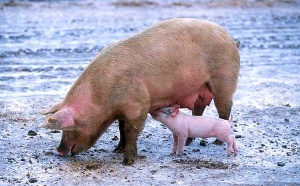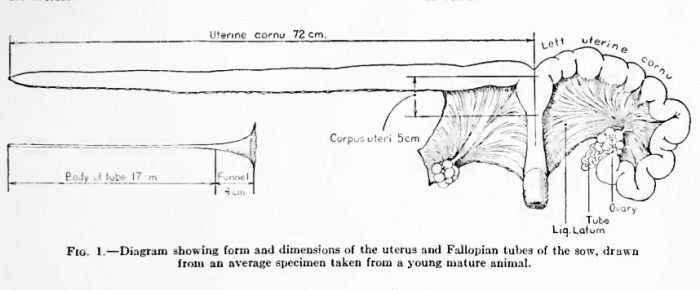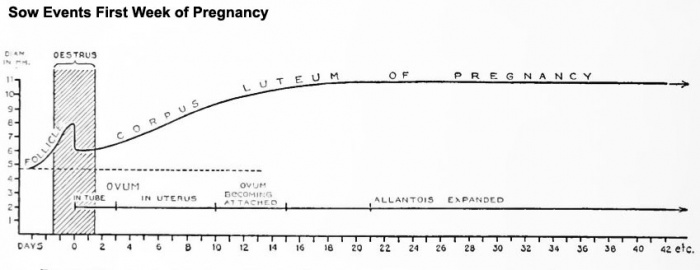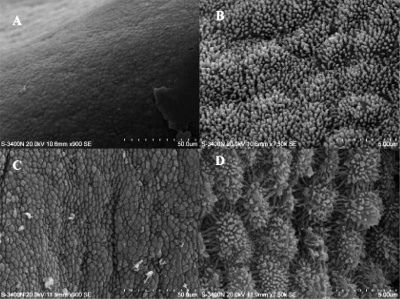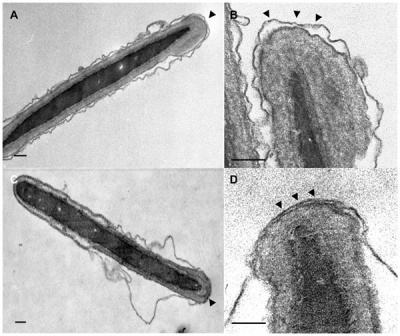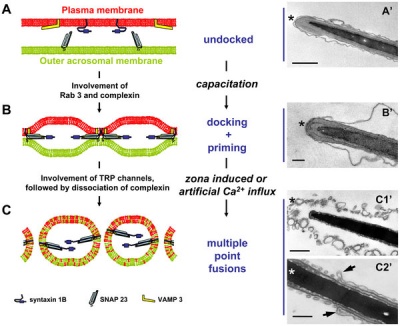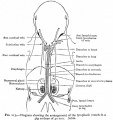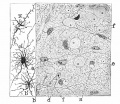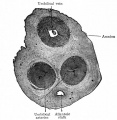Pig Development: Difference between revisions
mNo edit summary |
mNo edit summary |
||
| Line 14: | Line 14: | ||
|-bgcolor="F5FAFF" | |-bgcolor="F5FAFF" | ||
| | | | ||
* '''Porcine Pluripotent Stem Cells Derived from IVF Embryos Contribute to Chimeric Development In Vivo'''<ref name="PMID26991423"><pubmed>26991423</pubmed></ref> "Here, we derived a porcine pluripotent stem cell (pPSC) line from day 5.5 blastocysts in a newly developed culture system based on MXV medium and a 5% oxygen atmosphere. The pPSCs had been passaged more than 75 times over two years, and the morphology of the colony was similar to that of human embryonic stem cells." | |||
* '''An In Vivo Three-Dimensional Magnetic Resonance Imaging-Based Averaged Brain Collection of the Neonatal Piglet'''<ref name="PMID25254955"><pubmed>25254955</pubmed>| [http://www.plosone.org/article/info%3Adoi%2F10.1371%2Fjournal.pone.0107650 PLoS One.]</ref> "Due to the fact that morphology and perinatal growth of the piglet brain is similar to humans, use of the piglet as a translational animal model for neurodevelopmental studies is increasing. Magnetic resonance imaging (MRI) can be a powerful tool to study neurodevelopment in piglets, but many of the MRI resources have been produced for adult humans. Here, we present an average in vivo MRI-based atlas specific for the 4-week-old piglet." (More? [[Neural System - Postnatal]]) | * '''An In Vivo Three-Dimensional Magnetic Resonance Imaging-Based Averaged Brain Collection of the Neonatal Piglet'''<ref name="PMID25254955"><pubmed>25254955</pubmed>| [http://www.plosone.org/article/info%3Adoi%2F10.1371%2Fjournal.pone.0107650 PLoS One.]</ref> "Due to the fact that morphology and perinatal growth of the piglet brain is similar to humans, use of the piglet as a translational animal model for neurodevelopmental studies is increasing. Magnetic resonance imaging (MRI) can be a powerful tool to study neurodevelopment in piglets, but many of the MRI resources have been produced for adult humans. Here, we present an average in vivo MRI-based atlas specific for the 4-week-old piglet." (More? [[Neural System - Postnatal]]) | ||
* '''A gene expression atlas of the domestic pig'''<ref name="PMID23153189"><pubmed>23153189</pubmed></ref> "As an important livestock animal with a physiology that is more similar than mouse to man, we provide a major new resource for understanding gene expression with respect to the known physiology of mammalian tissues and cells. The data and analyses are available on the websites http://biogps.org and http://www.macrophages.com/pig-atlas." | * '''A gene expression atlas of the domestic pig'''<ref name="PMID23153189"><pubmed>23153189</pubmed></ref> "As an important livestock animal with a physiology that is more similar than mouse to man, we provide a major new resource for understanding gene expression with respect to the known physiology of mammalian tissues and cells. The data and analyses are available on the websites http://biogps.org and http://www.macrophages.com/pig-atlas." | ||
Revision as of 14:26, 21 March 2016
| Embryology - 19 Apr 2024 |
|---|
| Google Translate - select your language from the list shown below (this will open a new external page) |
|
العربية | català | 中文 | 中國傳統的 | français | Deutsche | עִברִית | हिंदी | bahasa Indonesia | italiano | 日本語 | 한국어 | မြန်မာ | Pilipino | Polskie | português | ਪੰਜਾਬੀ ਦੇ | Română | русский | Español | Swahili | Svensk | ไทย | Türkçe | اردو | ייִדיש | Tiếng Việt These external translations are automated and may not be accurate. (More? About Translations) |
Introduction
Pig (Sus scrofa) developmental model is studied extensively due to the commercial applications of pigs for meat production and for health issues such as obesity, cardiovascular disease, and organ transplantation (xenotransplantation).
Historically, there is an excellent description of the pig reproductive estrous cycle and the cyclic changes that occur within the ovary.[1]
Some Recent Findings
|
| More recent papers |
|---|
|
This table allows an automated computer search of the external PubMed database using the listed "Search term" text link.
More? References | Discussion Page | Journal Searches | 2019 References | 2020 References Search term: Pig Embryology <pubmed limit=5>Pig Embryology</pubmed> |
Taxon
Taxonomy ID: 9823
Genbank common name: pig
Inherited blast name: even-toed ungulates
Rank: species
Genetic code: Translation table 1 (Standard)
Mitochondrial genetic code: Translation table 2 (Vertebrate Mitochondrial)
Other names: wild boar, swine, pigs
Lineage (full): cellular organisms; Eukaryota; Fungi/Metazoa group; Metazoa; Eumetazoa; Bilateria; Coelomata; Deuterostomia; Chordata; Craniata; Vertebrata; Gnathostomata; Teleostomi; Euteleostomi; Sarcopterygii; Tetrapoda; Amniota; Mammalia; Theria; Eutheria; Laurasiatheria; Cetartiodactyla; Suina; Suidae; Sus
Animal Models
| Postnatal Animal Models | mouse | rat | pig |
|---|---|---|---|
| Pregnancy period (days) | 18 – 21 | 21 – 23 | 110 – 118 |
| Placenta type | Discoidal, decidual hemoendothelial choroidea |
Discoidal, decidual hemoendothelial choroidea |
Epitheliochorial |
| Litter size | 6 – 12 | 6 – 15 | 11 – 16 |
| Birth weight (g) | 0.5 – 1.5 | 3 – 5 | 900 – 1600 |
| Weaning weight male/female (g) | 18 – 25/16 – 25 | 55 – 90/45 – 80 | 6000 – 8000 |
| Suckling period (days) | 21–28 | 21 | 28–49 |
| Solid diet beginning (days) | 10 | 12 | 12 – 15 |
| Puberty male/female (week) | 4 – 6/5 | 6/6 – 8 | 20 – 28 |
| Life expectancy (years) | 1 - 2 | 2 - 3 | 14 – 18 |
| Table data - Otis and Brent (1954)[7] Links: timeline | |||
Normal Stages
The images below are from the 1897 Normentafeln zur Entwicklungsgeschichte der Wirbeltiere - Sus scrofa domesticus (Normal Plates of the Development of the Pig Embryo) by Franz Keibel
Uterus and Ovary
Diagram showing form and dimensions of the uterus and Fallopian tubes of the sow.[8] Drawn from an average specimen taken from a young mature animal.
Estrous Cycle
Female pig is called a sow.
Non-Pregnant
Events of the average cycle of 21 days in the non-pregnant sow.[8]
Diagram showing relationship between oestrua, ovulation, corpus luteum development, and the progress of the ova in the sow.
Pregnant
Events of the first weeks of pregnancy.[8]
Diagram showing relationship between oestrua, ovulation, corpus luteum development, and the progress of the ova in the sow.
Scanning electron microscope images of the endometrial surface of a Day 13 pregnant sow.[9]
Male Pig
Male pig is called a boar.
Capacitation alters the ultrastructure of the apical head and the acrosome of boar sperm.[10]
Model for capacitation-induced stable docking of the acrosome to the sperm plasma membrane.[5]
Pig Development
[[File:Keibel1897_plate01.jpg|thumb|400px|Images of pig development from 1897 book plate.
- The gestation period of a pig is 112 to 114 days.
- Female pigs can become pregnant at around 8 to 18 months of age.
- The pig has an estrus cycle occurring every 21 days if not bred.
- Male pigs become sexually active at 8 to 10 months of age.
- Embryos begin to attach to the uterus on days 13–14 of pregnancy.
- Day 15-20 implanted and expansion of allantois.
- A litter of piglets is between 6 and 12 piglets.
Data For Carnegie Stages Comparison Graph (Species/Days)
| Species | Stage | |||||||||||||||
| Human | Days | 20 | 22 | 24 | 28 | 30 | 33 | 36 | 40 | 42 | 44 | 48 | 52 | 54 | 55 | 58 |
| Pig | Days | 14 | 15 | 16 | 17 | 18 | 19 | 20.5 | 21.5 | 23 | 24 | 25.5 | 27.5 | 29 | 30.5 | 32.5 |
- Links: Carnegie Stage Comparison
Neural Development
The data below is summarised from an excellent study of early neural development in the pig.[11] The same authors have studied neural development in the rabbit.
- 7 somite embryo - first apposition of the neural folds occurs at somite levels 5-7. (corresponds to closure site I in mouse).
- next stage - rostral and caudal parts of the rhombencephalic folds appose, leaving an opening in between.
- at this stage four neuropores can be distinguished, of which the anterior and posterior ones will remain open longest. (two rhombencephalic closure sites have no counterpart in the mouse, but do have some resemblance to those of the rabbit)
anterior neuropore
- closes in three phases
- dorsal folds slowly align and then close instantaneously, the slow progression being likely due to a counteracting effect of the mesencephalic flexure
- dorso-lateral folds close in a zipper-like fashion in caudo-rostral direction
- final round aperture is likely to close by circumferential growth.
22 somite embryo - anterior neuropore is completely closed. (closure sites for the anterior neuropore in mouse embryo, none of these were detected in the pig embryo)
posterior neuropore
- closes initially very fast in the somitic region, but this process almost stops thereafter.
- stage 20-22 somites the posterior neuropore suddenly reduces in size but thereafter a small neuropore remains for 5 somite stages.
- closure of the posterior neuropore is completed at the stage of 28 somites.
8-20 somite embryos - the width of the posterior neuropore does not change, while the rate of closure gradually increases.
Additional Images
References
- ↑ Corner, G.W., Cyclic changes in the ovaries and uterus of swine, and their relations to the mechanism of implantation. Contributions to Embryology Carnegie Institution, 1922, No.64 117-146.
- ↑ <pubmed>26991423</pubmed>
- ↑ <pubmed>25254955</pubmed>| PLoS One.
- ↑ <pubmed>23153189</pubmed>
- ↑ 5.0 5.1 <pubmed>20585455</pubmed>
- ↑ <pubmed>19683851</pubmed>
- ↑ Otis EM and Brent R. Equivalent ages in mouse and human embryos. (1954) Anat Rec. 120(1):33-63. PMID 13207763
- ↑ 8.0 8.1 8.2 Corner, G.W., Cyclic changes in the ovaries and uterus of swine, and their relations to the mechanism of implantation. Carnegie Institution - Contributions to Embryology No.64 (1922) 117-146.
- ↑ <pubmed>20640155</pubmed>| PMC2904919
- ↑ <pubmed>20585455</pubmed>| PLoS One.
- ↑ <pubmed>10985427</pubmed>
Reviews
<pubmed></pubmed> <pubmed>22450280</pubmed> <pubmed>22127002</pubmed> <pubmed>21677026</pubmed> <pubmed>770410</pubmed> <pubmed>4596894</pubmed> <pubmed>4973146</pubmed> <pubmed>4951167</pubmed>
Articles
<pubmed></pubmed> <pubmed></pubmed> <pubmed></pubmed> <pubmed>20874819</pubmed>
Search PubMed
- pig development - All (22158) Review (1443) Free Full Text (6175)
- pig embryo - All (7265) Review (518) Free Full Text (1792)
Search Pubmed: pig development | pig embryo | Sus scrofa development
External Links
External Links Notice - The dynamic nature of the internet may mean that some of these listed links may no longer function. If the link no longer works search the web with the link text or name. Links to any external commercial sites are provided for information purposes only and should never be considered an endorsement. UNSW Embryology is provided as an educational resource with no clinical information or commercial affiliation.
- NCBI - Pig Genome
- USA - PigBase a computer database that includes information on papers published about gene mapping in the pig.
- NSW Agriculture - Pig breeds and breeding
- AGBU - Pig Genetics
| Animal Development: axolotl | bat | cat | chicken | cow | dog | dolphin | echidna | fly | frog | goat | grasshopper | guinea pig | hamster | horse | kangaroo | koala | lizard | medaka | mouse | opossum | pig | platypus | rabbit | rat | salamander | sea squirt | sea urchin | sheep | worm | zebrafish | life cycles | development timetable | development models | K12 |
Glossary Links
- Glossary: A | B | C | D | E | F | G | H | I | J | K | L | M | N | O | P | Q | R | S | T | U | V | W | X | Y | Z | Numbers | Symbols | Term Link
Cite this page: Hill, M.A. (2024, April 19) Embryology Pig Development. Retrieved from https://embryology.med.unsw.edu.au/embryology/index.php/Pig_Development
- © Dr Mark Hill 2024, UNSW Embryology ISBN: 978 0 7334 2609 4 - UNSW CRICOS Provider Code No. 00098G
